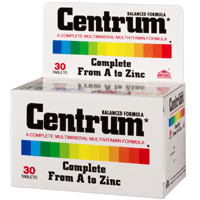TTAB Sustains 2(d) Opposition to "A thru Z Advantage" for Nutritional Supplements
Sustaining a Section 2(d) opposition to registration of the mark A THRU Z ADVANTAGE (in the stylized form shown immediately below) for "dietary and nutritional supplements," the TTAB found the mark likely to cause confusion with the registered mark FROM A TO ZINC for "vitamin and mineral preparations." Wyeth Holdings Corp. v. Walgreen Co., Opposition No. 91151171 (June 21, 2005) [not citable].
 Applicant Walgreen took no testimony and offered no evidence, but it did file a brief in which it made "a number of factual assertions." However, those assertions were not supported by any evidence, and thus they were essentially ignored by the Board.
Applicant Walgreen took no testimony and offered no evidence, but it did file a brief in which it made "a number of factual assertions." However, those assertions were not supported by any evidence, and thus they were essentially ignored by the Board.The Board found the involved goods to be legally identical for Section 2(d) purposes, since Opposer's goods "are included within the scope of Applicant's broadly identified goods." Because there are no limitations on the channels of trade, the Board was required to assume that they move in the same, normal channels of trade to the same class of purchasers. In any case, Walgreen admitted that Wyeth's goods may be sold at its stores.

The Board noted that when the goods are identical, a lesser degree of similarity between the marks is required to support a finding of likely confusion. Walgreen contended that the difference between the marks is the single du Pont factor that outweighs all others. The panel disagreed.
The Board considered "significant" the similarity in usage of "A" and "Z" to "A" and "ZINC." Moreover,
"[t]he connotation of the 'A THRU Z' portion of applicant's mark draws from the same well as opposer's FROM A TO ZINC mark. They convey the same general idea and stimulate the same mental reaction, namely, that the products run the full gamut of nutrients."
It observed that "similarity of connotation or commercial impression alone is sufficient to support a finding of likelihood of confusion ... even if the marks exhibit aural and optical dissimilarity when they convey the same general idea or stimulate the same mental reaction."
 The Board found the "A THRU Z" portion of Walgreen's mark to be the most prominent element, given the size of the "A" and "Z" and the position of "A THRU Z," and it concluded that "the similarities between the marks outweigh any points of dissimilarity."
The Board found the "A THRU Z" portion of Walgreen's mark to be the most prominent element, given the size of the "A" and "Z" and the position of "A THRU Z," and it concluded that "the similarities between the marks outweigh any points of dissimilarity."Finally, Walgreen admitted in its brief that Wyeth's mark is "fairly well known." The Board therefore considered FROM A TO ZINC to be a strong mark entitled to a broad scope of protection.
Considering all the du Pont factors, the Board ruled that "a likelihood of confusion exists."
Text Copyright John L. Welch 2005. All Rights Reserved.




0 Comments:
Post a Comment
<< Home